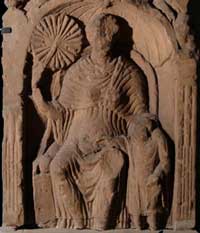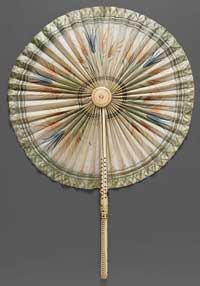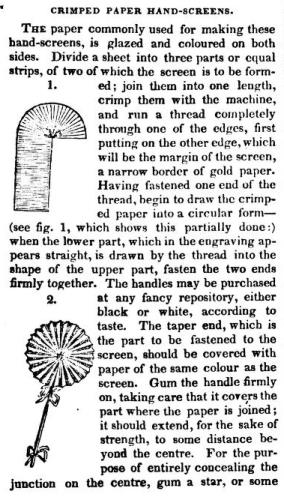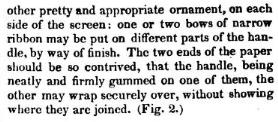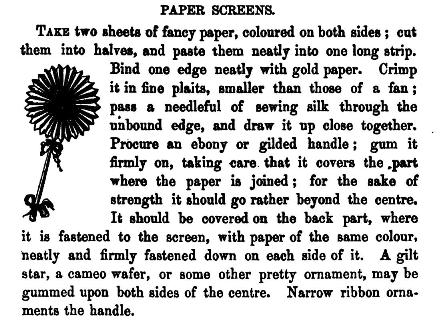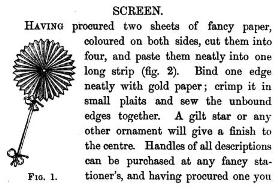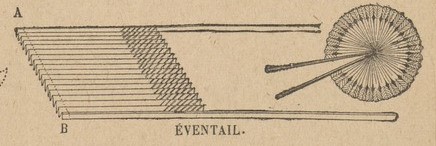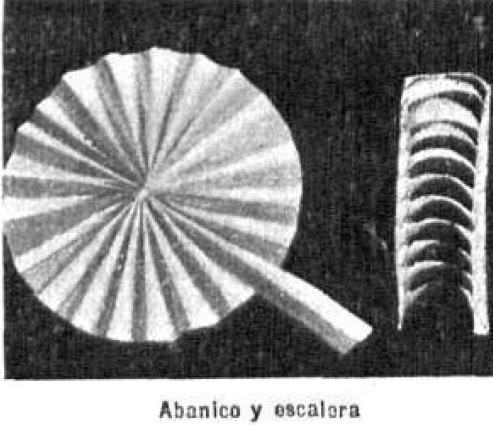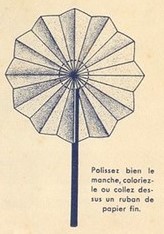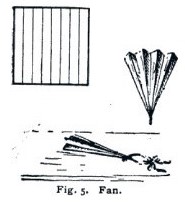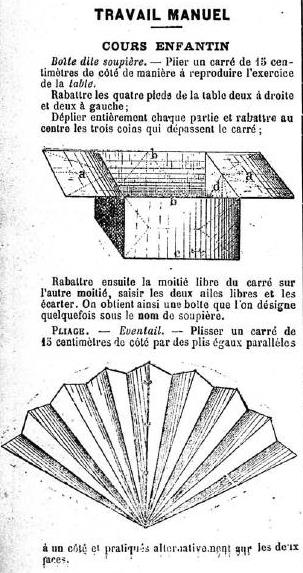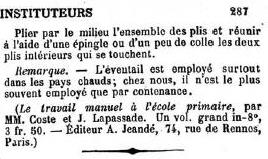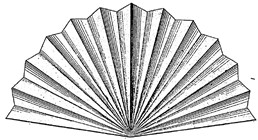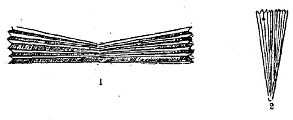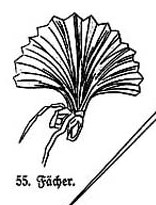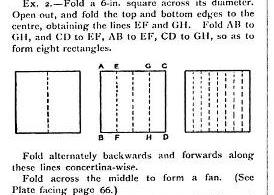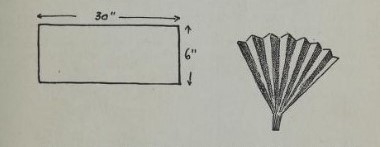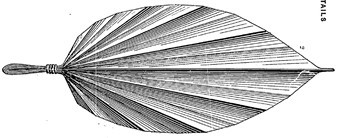| The Public Paperfolding History Project
Last updated 11/9/2025 x |
|||||||
| Pleated Paper Fans / Firescreens | |||||||
| This
page is being used to collect information about the
history of Pleated Paper Fans and handheld Firescreens.
Please contact me if you know any of this information is
incorrect or if you have any other information that
should be added. Thank you. Three different kinds of pleated paper fans are recorded on this page, circular fans, collapsible fans and leaf fans. Fans of all three types can be made of other materials as well as paper. ********** Circular Pleated Fans / Firescreens In Japan (and in publications by Japanese authors) 1713 A pleated circular fan, presumably made from paper, appears in a print from 'Shôtoku hinagata' (Patterns from the Shôtoku Era) aka Shotoku 3 by Nishikawa Sukenobu, which was published in 1713.
********** In Europe and the Americas Roman period
This picture of a carving on a Roman gravestone in Tullie Museum in Carlisle shows a pleated circular fan that was probably made of parchment. ********** 1100s According to https://www.fancircleinternational.org/history/fans-in-antiquity/: 'People kept on using these circular, pleated fans in Europe after the fall of Rome and throughout the Middle Ages. They carried them in Catholic church ceremonies, and also used them at home to keep cool.'
Pleated circular liturgical fan (1100s AD, Italy, now in Museum of Fine Arts, Boston) ********** 1829 'The Young Lady's Book', which was published by Vizetelly, Branston and Co in London, in 1829, contains instructions for making Crimped Paper Hand Screens using a crimping machine.
********** 1831 Very similar instructions appear in volume 3 of the American periodical 'Godeys Lady Book' for 1831.
********** 1833 Similar instructions, but without reference to a crimping machine, appear in 'The Girl's Own Book' by Lydia Marie Child, which was published by Clark Austin and Co in New York in 1833.
********** 1860 Similar instructions also appear in 'The Girl's Own Toymaker' by Ebenezer Landells and Alice Landells, which was published in 1860 by Griffin and Farran in London and Shephard, Clark and Brown in Boston.
********** 1889 A design for a circular fan, titled 'L'Écran Japonais' (The Japanese Screen) appears in 'Jeux et Travaux Enfantins - Première partie: Le Monde en Papier' by Marie Koenig and Albert Durand, which was published by Librairie Classique A. Jeande in Paris in 1889.
********** 1900 A way of making a pleated circular fan appears as 'Eventail' in 'Mes Jolie Jeux' by Henriette Suzanne Bres, which was published by Librairie Hachette in Paris in 1900.
********** 1905 An illustration of a circular pleated fan appears in the Buenos Aires edition of the magazine 'Caras y Caretas', Issue 238, of 25th March 1905, where it is just called 'abanico'.
********** 1918 As 'El Abanico Japonese' in 'Juguetes de Papel', which was published by Editorial Muntanola in Barcelona 1918. Two sticks are used to make this fan so that it can be opened or closed as required.
********** 1933 A circular fan appears as 'Eventail Rond' in 'Jeux de pliages' by Ferdinand Krch, which was published by Flammarion in Paris in 1933.
********** 1939 A Circular Pleated Fan appears in 'Plegado' by Rufino Yapur, which was published by Editores Independencia in Buenos Aires in 1939.
********** 1961 A Circular Pleated Fan appears as 'Rosette' in 'Wir Falten' by Joachim Schönherr and Gerta Schumann, which was published by Rudolf Arnold Verlag in Leipzig in 1961. ********** Collapsible Pleated Fans According to https://www.soas.ac.uk/gallery/traditionsrevised/origin-of-the-folding-fan.html: 'The folding fan (Ogi) as opposed to the much older fixed or flat fan (Uchiwa) is popularly thought to have originated in Japan around 670 A.D. made of wooden or bamboo strips threaded together and secured by a rivet or pivot. The oldest surviving wood strip fan (Hi-ogi) was discovered in Nara City, Japan dating to 747 A.D., while the oldest known Chinese or Korean folding fans of a similar type date to the 10th Century A.D. Remains of the oldest surviving paper folded fan were found in Akitsu, Japan and can be dated to the late 11th century/early 12th century A.D. While it is not known when paper folding fans were first made the oldest reference to a paper folding fan (Kawahori – bat wing) appears in 'Relationship with Japan of the Song History” written in 988 A.D., when it lists gifts including Kawahori and Hi-ogi from Japan to the Song Dynasty.' There is also an interesting essay on the origin of the pleated folding fan by Kanji Ishimura at https://www.fan.vg/media/pdf/Tracing_the_Origins_of_the_Folding_Fan.pd ********** 1874 The third edition of 'Der Kindergarten' by Hermann Goldammer, which was published by Carl Babel in Berlin in 1874, mentions, but does not picture, a design titled 'Der Facher' (the fan). ********** 1887 As 'Eventail' in 'Le Travail Manuel a L'ecole Primaire' by M. Coste et J. Lapassade, which was published by Lafon, Vve Ribaut et Tonnet in Pau and A Jeande in Paris in 1887.
********** 1889 A design for a paper fan, titled simply 'L'Eventail' (The Fan) appears in 'Jeux et Travaux Enfantins - Première partie: Le Monde en Papier' by Marie Koenig and Albert Durand, which was published by Librairie Classique A. Jeande in Paris in 1889.
********** Designs for simple fleated paper fans of various styles also appear: 1892 In 'The Prang Primary Course in Art Education: Part 1: The First Primary Year' by Mary Dana Hicks and Josephine C Locke, which was published by the Prang Educational Company in Boston in 1892.
********** 1893 In the 30th April 1983 issue of 'Journal des Instituteurs'. This is extracted from the book 'Le Travail Manuel a L'ecole Primaire, by M. Coste et J. Lapassade, which had been published in 1887.
********** 1894 As 'Eventail ordinaire' in 'Jeux et Occupations Pour les Petits: Guide des Mères et des Institutrices' by Henriette Suzanne Brés was published by Librairie Classique Fernand Nathan in Paris in 1894.
********** 1899 In 'Art Instruction in Primary Schools: Second Year' by Mary Dana Hicks was published by The Prang Educational Company in Boston, New York and Chicago in 1899.
********** In 'Le Livre des Amusettes' by Toto, which was published in Paris by Charles Mendel in 1899.
********** 1910 As 'Fächer' (the fan) in Part 2 'Das Flechten' of 'Die Frobelschen Beschaftigungen' by Marie Muller-Wunderlich, which was published by Friedrich Brandstetter in Leipzig in 1910.
********** As 'A Fan' in 'Handicraft in the School', which was issued in four volumes by Gresham Publishing in London in 1910.
********** 1931 Designs for single-sheet and double-sheet collapsible pleated fans appear in the revised 3rd edition of 'Lustiges Papierfaltbüchlein' by Johanna Huber, which was published by Otto Maier in Ravensburg, Germany in 1931.
**********
********** 1939 In 'Plegado' by Rufino Yapur, which was published by Editores Independencia in Buenos Aires in 1939.
********** As 'Paper Fans' in 'Fun with Paper' by Joseph Leeming, which was published by Spencer Press Inc in Chicago in 1939.
********** Leaf Fans 1894 As far as I know this design first occurs as 'Eventail feuille de palmier' in 'Jeux et Occupations Pour les Petits: Guide des Mères et des Institutrices' by Henriette Suzanne Brés was published by Librairie Classique Fernand Nathan in Paris in 1894.
********** |
|||||||

